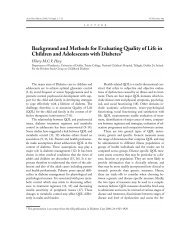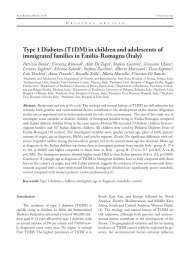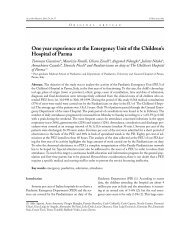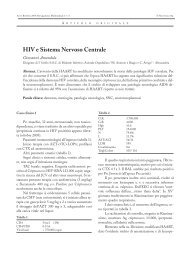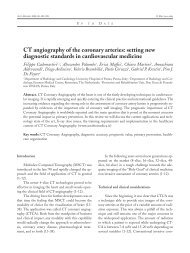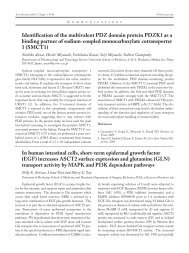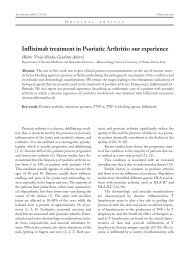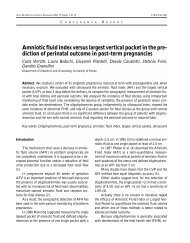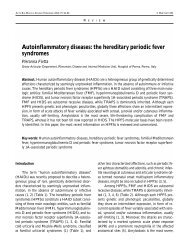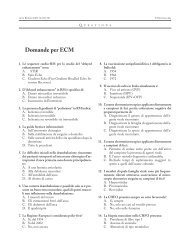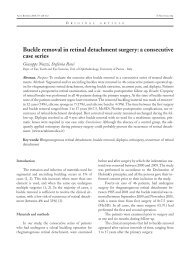Short reports+frontesp96-98 - Acta Bio Medica Atenei Parmensis
Short reports+frontesp96-98 - Acta Bio Medica Atenei Parmensis
Short reports+frontesp96-98 - Acta Bio Medica Atenei Parmensis
Create successful ePaper yourself
Turn your PDF publications into a flip-book with our unique Google optimized e-Paper software.
102 <strong>Short</strong> Reports<br />
gh more recently it has been suggested that the higher<br />
incidence of co-morbidities in this group of patients,<br />
rather than age alone, is responsible for the increase<br />
perioperative risk. On the other hand, predictive factors<br />
for mortality are undoubtedly ASA, the time interval<br />
between onset of symptoms and hospitalization,<br />
a stoma or palliative by-pass, or a non-therapeutic laparotomy.<br />
Palliation may be the use of self-expanding<br />
metallic stents in case of distal colonic obstruction or<br />
gastro-duodenal obstruction, the creation of a stoma,<br />
or the use of endoscopy. Conclusions: The goal of surgeons<br />
in the treatment of high risk patients who need<br />
to undergo emergency surgery is to prolong survival.<br />
This goal can be achieved only by careful assessment<br />
of patients on a case to case basis, paying particular attention<br />
to the multi-factorial nature of morbidity and<br />
mortality. Surgical palliation must be reserved to those<br />
severe cases (ASA IV-V) that are already in poor<br />
pre-operative status<br />
The role of the endovascular procedures in<br />
occlusive vascular disease<br />
C. delli Carpini, B. Amato, P. Addeo, V. Di Maio, F.<br />
Persico<br />
Department of General Surgery, Geriatrics, Oncology and Advanced<br />
Technologies, University of Naples “Federico II”, Naples,<br />
Italy<br />
Objectives: In these study we retrospectively reviewed<br />
our experience of endovascular procedures<br />
performed for lower extremity ischemia due stenotic<br />
lesions. Materials and methods: A total, of 120 procedures<br />
were performed by our division between January<br />
2002-december 2004. Of these 85 involved balloon<br />
angioplasty. The median age of the patients who underwent<br />
these 85 balloon angioplasty was 74±0.5 years<br />
old; 70% were male; 40% had a history of diabetes<br />
mellitus, and 15% had ESRD. Indications for the procedures<br />
included acute ischemia (6 cases), critical<br />
ischemia (rest pain, gangrene, or ischemic ulcers in 78<br />
cases), severe claudication (36 cases). Results: 45 of the<br />
procedures were percutaneous, and the remaining 40<br />
were combined with some type of open procedure.<br />
Those performed as an open tecnique were in combination<br />
with a bypass (22 cases) and in combination<br />
with a patch angioplasty (18 cases). Balloon angioplasties<br />
were performed of the iliac arteries (40 cases), the<br />
superficial femoral artery (29 cases), the popliteal artery<br />
(6 cases), the tibial vessels (10 cases). Intraoperative<br />
complications included 2 dissections; inability to<br />
dilate the lesion adequately (1 case), and rupture of<br />
one iliac lesion that underwent open repair. A total of<br />
36 stents are implanted, stents were initially used highly<br />
selectively but recently are now being deployed<br />
more liberally in the iliac arteries. Conclusions: Based<br />
on these data, we suggest that balloon angioplasty in<br />
association with stent implant are a safe procedure. In<br />
general endovascular stents have two potential therapeutic<br />
advantages in the arteries: salvage after abrupt<br />
postangioplasty closure and reduction of restenosis. In<br />
our hands the most successful application of stents has<br />
been for the treatment of lengthy dissection planes after<br />
succeseful recanalization in occluded iliac arteries.<br />
Acute cholecystitis in the erderly. Our experience<br />
V. Di Maio, G. Diamantis, F. Persico, G. Aprea, B. Amato<br />
Department of General and Geriatric Surgery, University of<br />
Naples “Federico II”, Naples, Italy<br />
Objective: The treatment of acute cholecystitis is<br />
still a matter of debate of considerable importance in<br />
the elderly also because the mortality and morbility in<br />
this kind of patients are higher than the youth ones.<br />
We want to show the results of our surgical timing.<br />
Materials and methods: Since July 2002 to December<br />
2004 in our surgical department we treated 96 patients<br />
suffering from acute cholecystitis, 54 of whom<br />
were aged over 70. The group consisted of 52 females<br />
and 44 males. Their mean age was 75.Acute cholecystitis<br />
was confirmed by clinical symptoms, clinical signs,<br />
laboratory tests and US. Within five days of onset<br />
of symptoms in 40 cases we used laparoscopic and<br />
in 5 open approach. Patients in which the symptoms<br />
were present for more than five days were submitted<br />
first to antibiotics therapy (sintetic penicillins and<br />
third generation cefalosporins) and/or percutaneous<br />
cholecystostomy and then to surgical approach, 30<br />
with laparoscopic and 16 with open approach. Five<br />
patients were not operable for surgical absolute contraindication<br />
(heart failure etc…). Results: We needed



